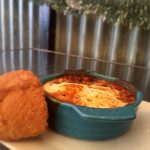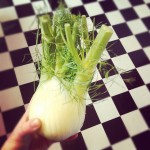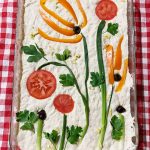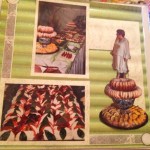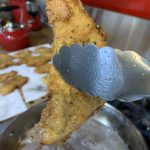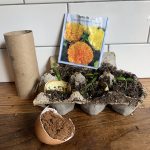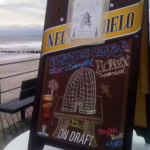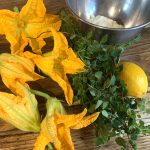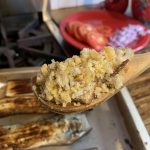by Paula D.
on July 31, 2020 12:16 pm in Rockaway
I’ve been spending a lot of time on the beach. Where else would I be this time of year? And I’m sharing the sand with some of Rockaways’ pro beach-goers. These local folks set up at 10am and break down after sunset. The vibe by me in the 90’s isn’t showy beach swag, it’s the opposite. Use what you have, recycle, live frugally…. the Rockaway hippie mentality.
I learned some useful beach hacks from the crew this weekend and I want to pass along these pro-tips:
- The jar cup. My friend Beth Perkins started this trend. Instead of a cup, bring a jar filled to the brim with ice. By the time you set up shop on the sand, your water is melted, ice cold and ready to drink. And the big benefit of the jar cup is the cover. No spillage of your rose or rum punch when using this vessel.
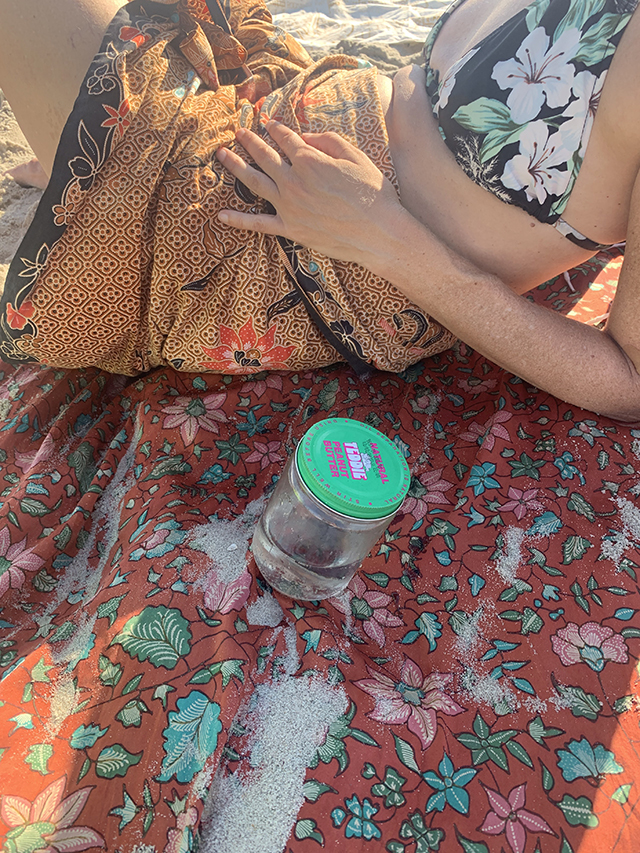
- Shot Glass: Before Covid, it wasn’t uncommon for the locals to pass around the bottle of tequila while the air cooled and the sun set. Now that’s a hard no. While plastic is shunned in Rockaway, every so often you do come across a plastic bottle. And then we’ll reuse or repurpose. A great example of this is Kevin Tavarez’s shot glass hack. Last week on the beach, he showed me a sweet method to make a shot glass… “ when you’re in a pinch”. Someone in the group will have a knife in their cooler or something of the sort. Just cut off the top part of a water bottle, flip it around, pour, cheers and down the hatch.

- Sand Pillow: This may be by far the most inventive beach hack in the beach bum handbook. My friend Melissa Draugsvold pulls out of her tote a pillowcase cover, the kind with a zipper. She begins to fill it with sand, zip’s it up, places it on her blanket and lays down. Brilliant! I tested it out and it’s super comfortable.
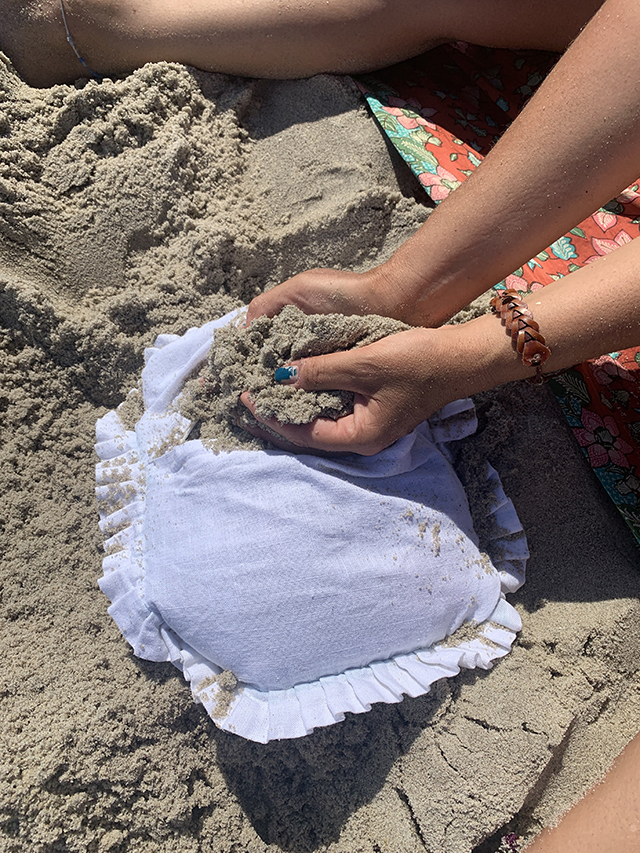
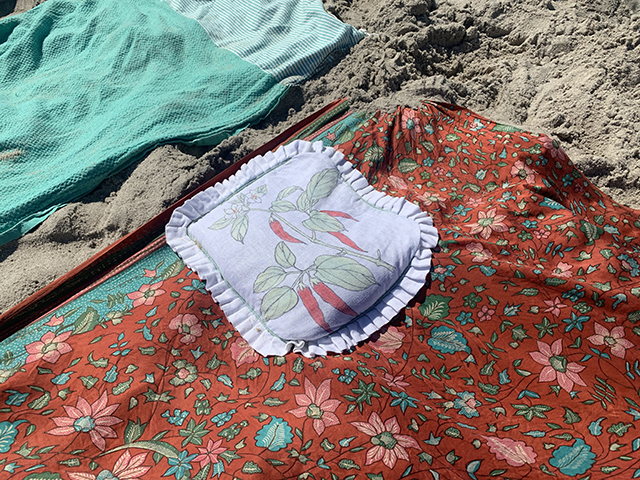
- Sand Lounger: Mike O’Toole, Rockaway native and master beach dude, chimed in after I was “wowed” over Melissa’s beach pillow. “My life’s a beach hack,” He said and began making the sand lounger. “It involves some sculpting, but worth the build out.” he said. So the idea is to build up a pillow sand pile and then dig out a hole for your “beach bum”. From the pillow to the bum spot sculpt a slope for your back. Cover the construction with your towel and you have a lounger, without lugging a chair. This is also excellent comfort.

In general bringing less is more to the beach. Sometimes I don’t even bother with flip flops. Luging minimal gear is best because you don’t know where the day will bring you and even though we all live steps from the beach, the thought of going back to the house to drop stuff off a bummer.
Summer in Rockaway allows us to live for the joy of living without restraints and we’re in high season soaking it all in, beach bum style.
For more of the day-to-day follow me on IG: @theglorifiedtomato
Previously published in The Wave.
by Paula D.
on July 31, 2020 12:13 pm in Gardening
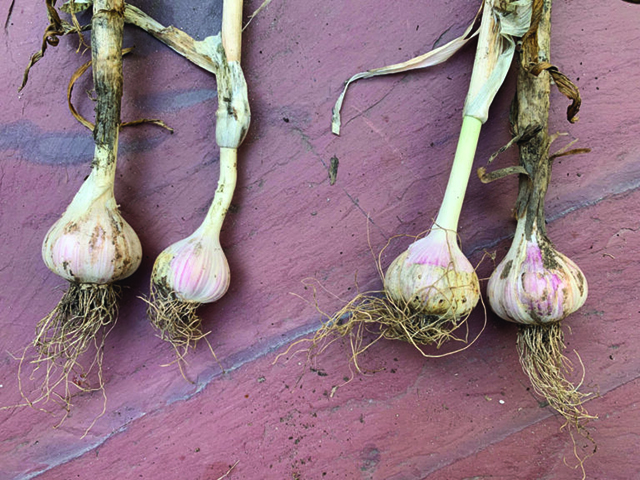
If you’ve been reading along, you know that I harvested my first batch of garlic two weeks ago but was a little unsure if it was the right time. This is the case with many root crops and it’s a trial and error learning process.
I decided I’d harvest a few at a time for the next several weeks. This would allow me to gauge and record sizing and ripeness based on timing. Over the 4th of July weekend, I collected two more bulbs, carefully from under the soil. They were bigger than the first batch!! So I think I may have been a little early in starting. Removing the scapes was significant. The energy to grow the scape and flower drain from the bulb. Removing them encourages more growth.
Speaking of scapes, I’ve used them in a few meals last week and it worked wonderfully. The flavor is similar to garlic. Just remember if you want pungency, use more scapes. I was talking with a friend on the porch and she mentioned garlic scape pesto. The stem of the scape can be a bit tough. Using a food processor to break them down for making pesto or other spreads works well.
For long-term storage and use, garlic needs to be cured. I didn’t cure correctly for the first 3 I pulled last week. I can tell because a few dark spots, probably mold, appeared on the garlic “wapper”. I”ve removed those parts so I can still cook with those this week. With this second batch, I need to be more careful. The problem is I don’t have a cool place in the house. We only have AC in the bedroom so the conditions have been a challenge.
According to theslpruc.com this is the best way to cure garlic:
Start by brushing off any soil remnants clinging to the bulbs. Do not wash them off or get the bulbs wet. Leave the stalks and roots on the bulbs while they cure. Tie bundles of stems together with twine, and hang bulb-side down in a cool, dark space, like a basement.
Allow the bulbs to cure for three to four weeks. Keep out of sunlight, as it can change the flavor of fresh garlic. Also note: Light and moisture are garlic’s worst enemies, as they both cause mold to grow. Once the tops and roots have dried, cut them off and clean the garlic by removing the outer papery skin. Be careful not to expose any of the cloves.
And to store:
Keep your garlic in a dark, cool place (32 to 40 degrees) where it will still get some air circulation. Braiding and hanging garlic is a good way to store it. You can also store garlic in a mesh bag. Check periodically to make sure the garlic is not going soft or sprouting.
In total I only have about 10 bulbs. The only interest in curing I have is to keep two bulbs for next year’s planting. I have a few more tries to get this process right and I’ll keep you posted on it!
If you missed the first article on garlic harvesting, find it here.
Follow me for the day-to-day on IG @theglorifiedtomato
Previously published in The Wave.
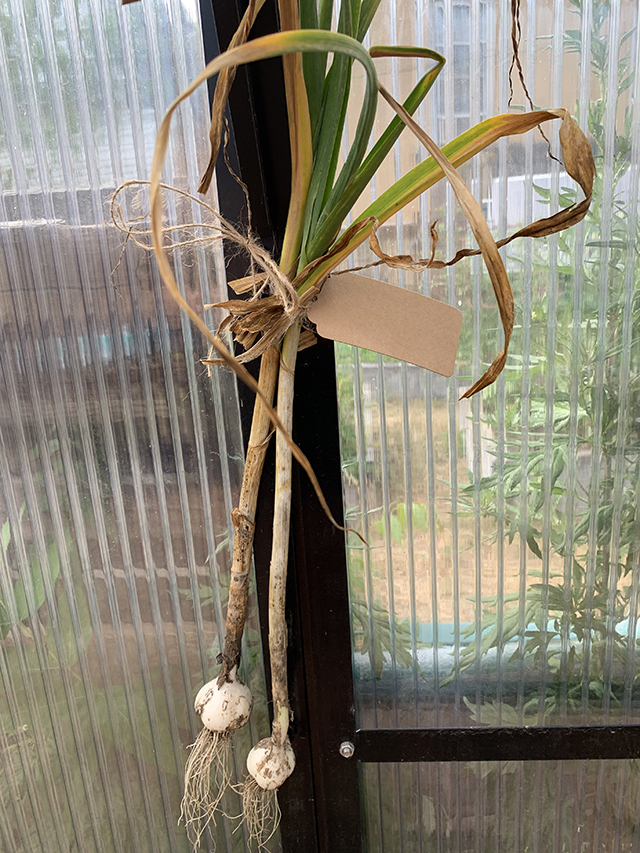
Besides humans, what else takes nine months to grow?
The answer – garlic.
In late October I planted garlic for the first time with guidance from my neighbor Diane. We’re both members of the Beach 91st Street Community Garden and that’s where I planted my first crop. In April, I saw sprouts and I’ve been anticipating and monitoring ever since.
I planted the hardneck variety. Unlike most vegetables, garlic’s season is the opposite – plant in the fall, harvest in the summer. Garlic needs a long period of cold winter temperatures to encourage the seed to divide and grow into separate cloves which then forms a head of garlic. I learned this process is called vernalization. Garlic is triggered to bulb when the day length increases. How does it know the days are getting longer? So fascinating.
Two weeks ago, close to my “due date”, I started to binge-watch garlic harvesting videos on Youtube. I learned a lot but I’m still a little confused on best practices.
This is what I’ve concluded so far:
- Once scapes form, the plant needs 3-4 more weeks, then harvest. Cut off the scapes so the energy goes to growing the bulb and not the flower.
- Pre-check – carefully dig around the bulb with your fingers. If the bulb looks very small, cover it back up with soil. If it looks substantial and has some “paper wrapping” it’s ready. To harvest, carefully dig around the bulb with your fingers or a trowel, slowly and carefully loosen the roots and pull up.
- Harvest when ⅓ of the leaves are brown. These leaves are actually the natural “paper” covering your familiar seeing, that wrap garlic.
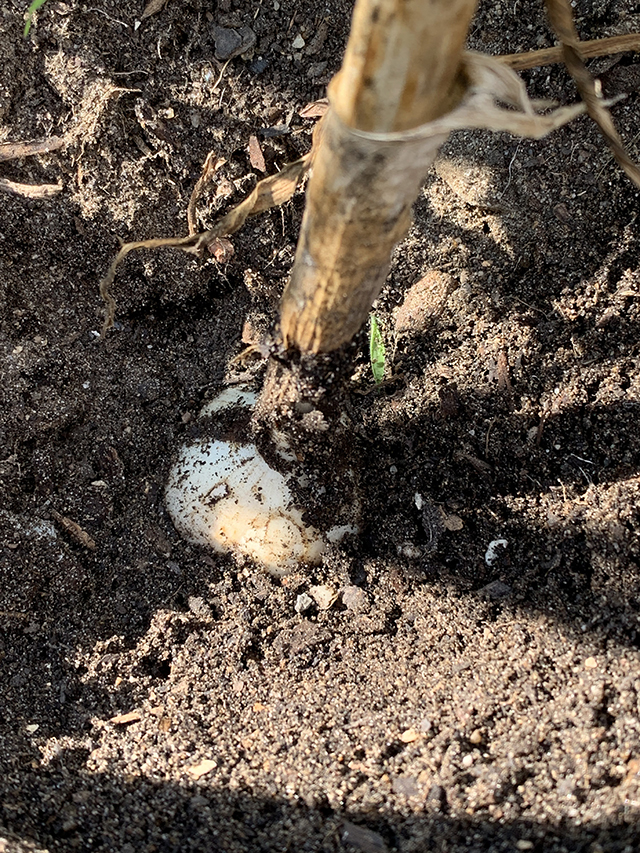
Many factors determine the time in which garlic is ready for harvest – the temperature that season, rainfall, soil, and garden zone. I thought I was ready to harvest last weekend but upon closer inspection, I wasn’t sure. It’s all about the leaves. Two or three on each plant died back completely but others had brown tips. Does that count? To further confuse things, I’ve had scapes for about two weeks.
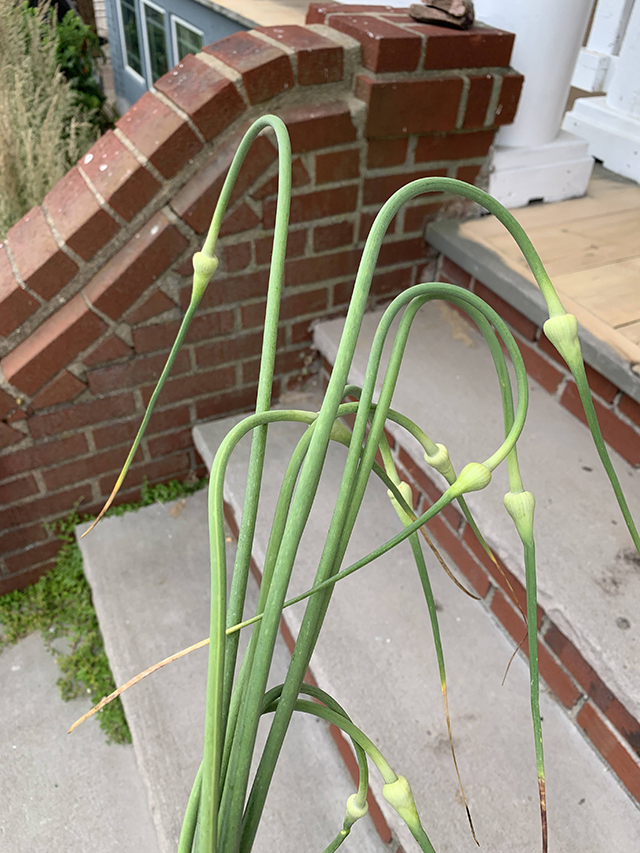
My friend Kristi happened to be in the garden and we were discussing, “to harvest or not to harvest”. She suggested conducting an experiment – harvest some now, some in another week, and the rest of the crop in 3 weeks. Kristi reminded me to take photos, so I can compare and contrast the growth from each micro-harvest. And then I’ll have that documentation for next year. Great advice and that’s what I ended up doing!
The two I harvested looked on the small side but then again it’s homegrown. We’re used to seeding bulbs from the supermarket, most times imported from China, not organic and pumped up with fertilizers – like garlic on steroids. So who knows, only my experiment will shed more light on this matter. Next week I’ll pull out two more and document the size. It’s all a learning process and I’m willing to put in the effort.
There’s a whole curing process that I’ll need to figure out next, to be continued…
For more of the back story, find my column on planting garlic from last October here. And for the day to day follow Paula on IG @theglorifiedtomato
by Paula D.
on June 23, 2020 8:36 am in Food
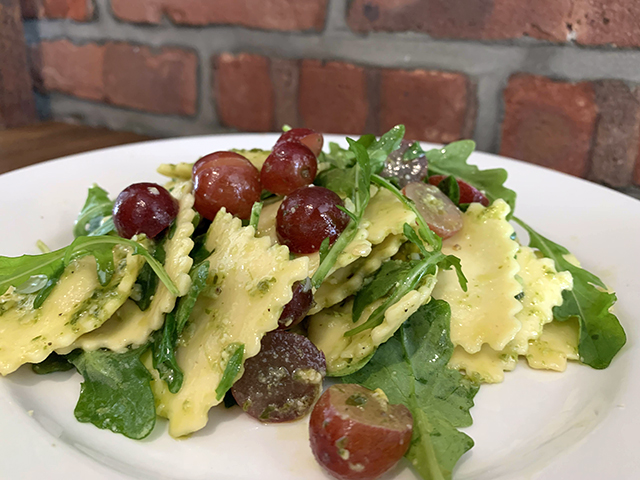
I’m obsessed with Queer Eye. I’ve binged-watched the new season already and I’m bummed I have to wait so long for more. My husband tolerated it, but would remark here and there when he saw me watching the show in bed, tearing up with a glass of wine in hand. “… but Matt, The Fab 5 are changing people’s lives!!”
If you’re unfamiliar with the re-make Netflix show:
“The style experts on Queer Eye forge relationships with men and women who often have different beliefs from them, leading to moments of social commentary interspersed with style advice. Advising people in need of lifestyle makeovers are food and wine specialist Antoni Porowski, interior designer Bobby Berk, grooming consultant Jonathan Van Ness, fashion designer Tan France and culture expert Karamo Brown”.*
In Episode 5, the guys head to the Jersey Shore to makeover Ryan Dyer, AKA, DJ High Def. His internal struggle to continue with his Jersey DJ career or to conform to the norm is why his family nominated him for the show.
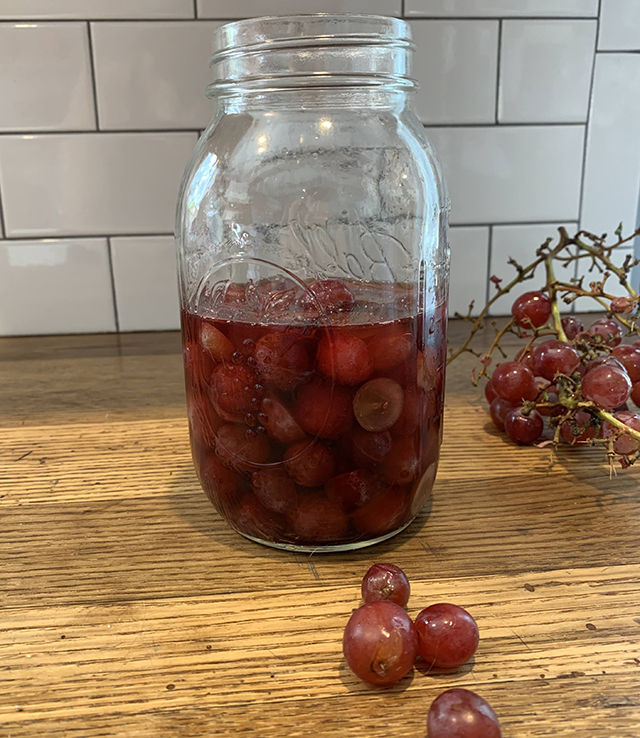
In the cooking segment of the episode, Antoni teaches Ryan how to make a simple, well-rounded Italian meal that he can share with his family or to impress a date. “Cooking is sexy”. Antoni explains. “The amount of effort Ryans put into GTL-ing**, means there’s no reason he can’t put that same energy and care into cooking.” Umm… yes Antoni!
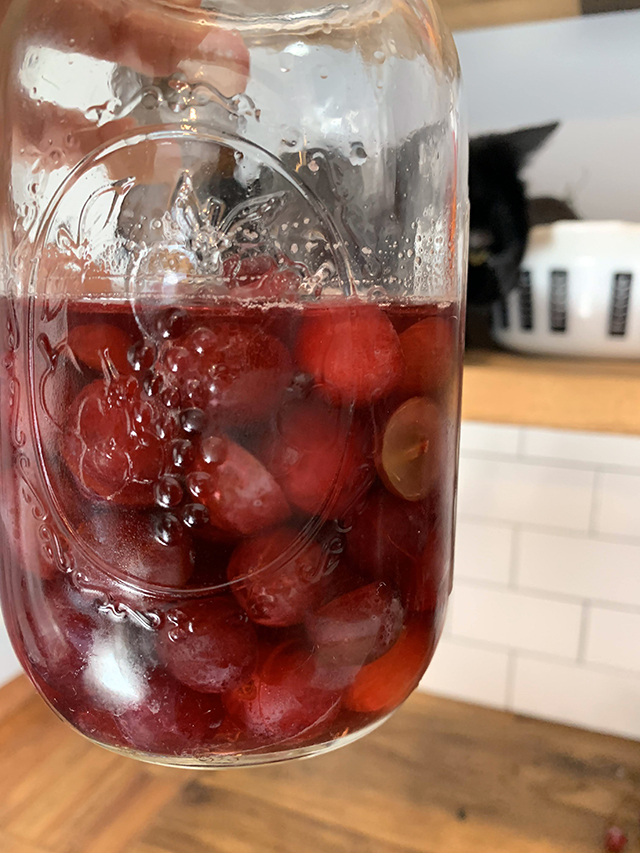
What caught my attention about Antoni’s Pesto Chicken Salad, was the pickled grape ingredient. I’ve never heard of it and I wanted to give it a try. While grapes and pasta are both Italian staples, I’d never think to combine the two.
I amended the recipe, omitting the chicken to make it a vegetarian dish. I also used my own pesto recipe which can be found here.
Herbaceous Pasta Salad
Ingredients:
For the pesto:
2 cups fresh basil leaves, packed
1/2 cup freshly grated pecorino romano
1/2 cup extra virgin olive oil
1/3 cup pine nuts
2 medium sized garlic cloves, minced
½ lemon squeezed
Salt and freshly ground black pepper to taste
For the Meal:
1 pound fresh pasta
3 handfuls of baby arugula
1 cup red grapes
½ cup red wine vinegar
Pecorino Romano to taste
Directions:
Step 1: Mix all the pesto ingredients in a food processor except the olive oil, salt and pepper. Once roughly chopped, slowly add the olive oil, then salt and pepper to taste.
Step 2: Add halved red grapes into red wine vinegar for a quick pickle effect.
Step 3 (if you’re including chicken): season the chicken breasts with salt and pepper then fry whole in a pan with some olive oil for about 8 to 12 minutes on medium. Flip the chicken occasionally. Cool and slice into chunks.
Step 4: Cook the fresh pasta according to instructions. Usually only needs 5 minutes in the water. Strain and add to a mixing bowl with the pesto, pickled grapes and baby arugula. Top with some grated cheese.
The verdict… easy, unique and delicious! In total it took about an hour from start to finish. If you make pesto in advance, as I do with my August basil harvest, the recipe would only take about 25 minutes to prepare. The overall aesthetic is so pro. The pickled grapes adds a zing and sweetness that works very well with the nutty flavor of the pesto. And the arugula gives just the right amount of bitterness and lightens up the meal. Fresh greens, herbs and grapes makes this a perfect summertime meal.
Antoni you are my hero!
For the day-to-day on instagram @theglorifiedtomato
*Source: google sidebar
** Gym, Tanning, Laundry.

















